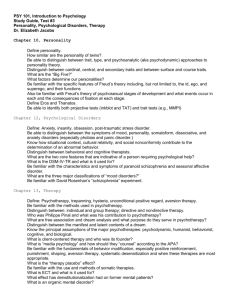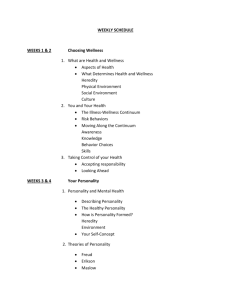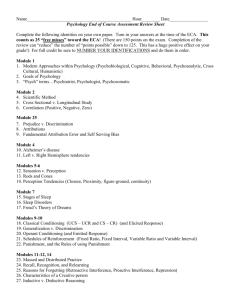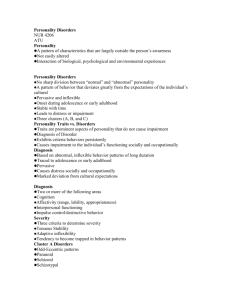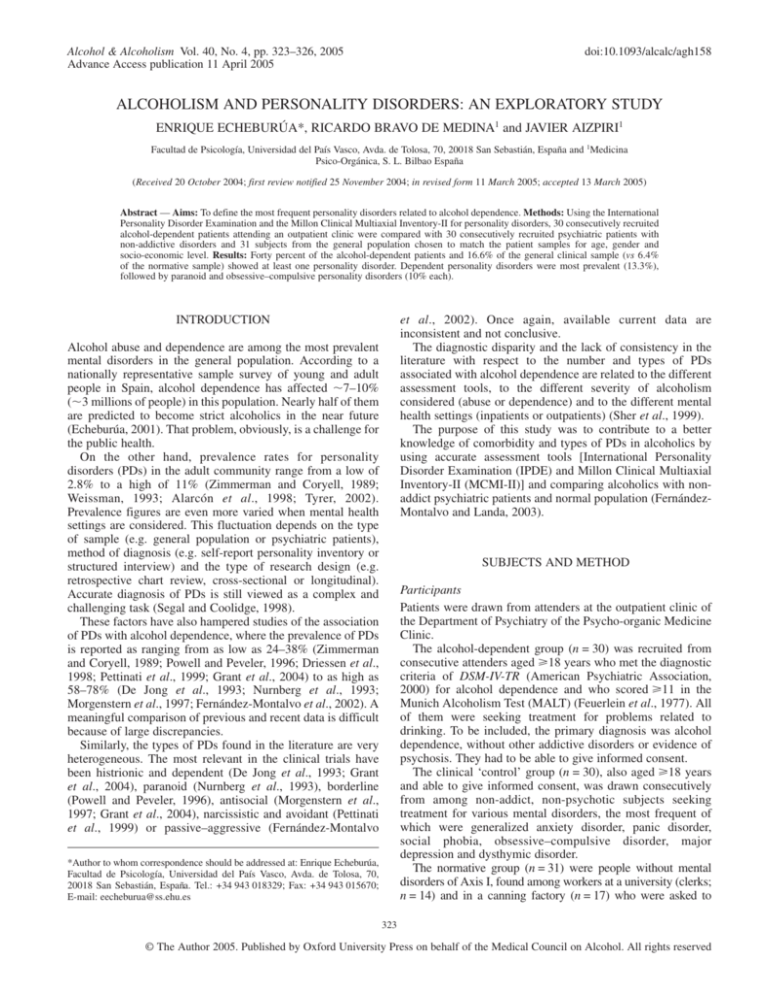
Alcohol & Alcoholism Vol. 40, No. 4, pp. 323–326, 2005
Advance Access publication 11 April 2005
doi:10.1093/alcalc/agh158
ALCOHOLISM AND PERSONALITY DISORDERS: AN EXPLORATORY STUDY
ENRIQUE ECHEBURÚA*, RICARDO BRAVO DE MEDINA1 and JAVIER AIZPIRI1
Facultad de Psicología, Universidad del País Vasco, Avda. de Tolosa, 70, 20018 San Sebastián, España and 1Medicina
Psico-Orgánica, S. L. Bilbao España
(Received 20 October 2004; first review notified 25 November 2004; in revised form 11 March 2005; accepted 13 March 2005)
Abstract — Aims: To define the most frequent personality disorders related to alcohol dependence. Methods: Using the International
Personality Disorder Examination and the Millon Clinical Multiaxial Inventory-II for personality disorders, 30 consecutively recruited
alcohol-dependent patients attending an outpatient clinic were compared with 30 consecutively recruited psychiatric patients with
non-addictive disorders and 31 subjects from the general population chosen to match the patient samples for age, gender and
socio-economic level. Results: Forty percent of the alcohol-dependent patients and 16.6% of the general clinical sample (vs 6.4%
of the normative sample) showed at least one personality disorder. Dependent personality disorders were most prevalent (13.3%),
followed by paranoid and obsessive–compulsive personality disorders (10% each).
INTRODUCTION
et al., 2002). Once again, available current data are
inconsistent and not conclusive.
The diagnostic disparity and the lack of consistency in the
literature with respect to the number and types of PDs
associated with alcohol dependence are related to the different
assessment tools, to the different severity of alcoholism
considered (abuse or dependence) and to the different mental
health settings (inpatients or outpatients) (Sher et al., 1999).
The purpose of this study was to contribute to a better
knowledge of comorbidity and types of PDs in alcoholics by
using accurate assessment tools [International Personality
Disorder Examination (IPDE) and Millon Clinical Multiaxial
Inventory-II (MCMI-II)] and comparing alcoholics with nonaddict psychiatric patients and normal population (FernándezMontalvo and Landa, 2003).
Alcohol abuse and dependence are among the most prevalent
mental disorders in the general population. According to a
nationally representative sample survey of young and adult
people in Spain, alcohol dependence has affected 7–10%
(3 millions of people) in this population. Nearly half of them
are predicted to become strict alcoholics in the near future
(Echeburúa, 2001). That problem, obviously, is a challenge for
the public health.
On the other hand, prevalence rates for personality
disorders (PDs) in the adult community range from a low of
2.8% to a high of 11% (Zimmerman and Coryell, 1989;
Weissman, 1993; Alarcón et al., 1998; Tyrer, 2002).
Prevalence figures are even more varied when mental health
settings are considered. This fluctuation depends on the type
of sample (e.g. general population or psychiatric patients),
method of diagnosis (e.g. self-report personality inventory or
structured interview) and the type of research design (e.g.
retrospective chart review, cross-sectional or longitudinal).
Accurate diagnosis of PDs is still viewed as a complex and
challenging task (Segal and Coolidge, 1998).
These factors have also hampered studies of the association
of PDs with alcohol dependence, where the prevalence of PDs
is reported as ranging from as low as 24–38% (Zimmerman
and Coryell, 1989; Powell and Peveler, 1996; Driessen et al.,
1998; Pettinati et al., 1999; Grant et al., 2004) to as high as
58–78% (De Jong et al., 1993; Nurnberg et al., 1993;
Morgenstern et al., 1997; Fernández-Montalvo et al., 2002). A
meaningful comparison of previous and recent data is difficult
because of large discrepancies.
Similarly, the types of PDs found in the literature are very
heterogeneous. The most relevant in the clinical trials have
been histrionic and dependent (De Jong et al., 1993; Grant
et al., 2004), paranoid (Nurnberg et al., 1993), borderline
(Powell and Peveler, 1996), antisocial (Morgenstern et al.,
1997; Grant et al., 2004), narcissistic and avoidant (Pettinati
et al., 1999) or passive–aggressive (Fernández-Montalvo
SUBJECTS AND METHOD
Participants
Patients were drawn from attenders at the outpatient clinic of
the Department of Psychiatry of the Psycho-organic Medicine
Clinic.
The alcohol-dependent group (n = 30) was recruited from
consecutive attenders aged 18 years who met the diagnostic
criteria of DSM-IV-TR (American Psychiatric Association,
2000) for alcohol dependence and who scored 11 in the
Munich Alcoholism Test (MALT) (Feuerlein et al., 1977). All
of them were seeking treatment for problems related to
drinking. To be included, the primary diagnosis was alcohol
dependence, without other addictive disorders or evidence of
psychosis. They had to be able to give informed consent.
The clinical ‘control’ group (n = 30), also aged 18 years
and able to give informed consent, was drawn consecutively
from among non-addict, non-psychotic subjects seeking
treatment for various mental disorders, the most frequent of
which were generalized anxiety disorder, panic disorder,
social phobia, obsessive–compulsive disorder, major
depression and dysthymic disorder.
The normative group (n = 31) were people without mental
disorders of Axis I, found among workers at a university (clerks;
n = 14) and in a canning factory (n = 17) who were asked to
*Author to whom correspondence should be addressed at: Enrique Echeburúa,
Facultad de Psicología, Universidad del País Vasco, Avda. de Tolosa, 70,
20018 San Sebastián, España. Tel.: +34 943 018329; Fax: +34 943 015670;
E-mail: eecheburua@ss.ehu.es
323
© The Author 2005. Published by Oxford University Press on behalf of the Medical Council on Alcohol. All rights reserved
324
E. ECHEBURÚA et al.
collaborate in research and were motivated to do so by offering
them feedback on their personality test results. A selection was
made to achieve a group who matched the clinical groups in
terms of age, gender and social class, the clinical groups having
by chance turned out to be reasonably matched on these
measures. All assessments were made during 2003.
Assessment measures
The Structured Clinical Interview is an instrument aimed at
assessing, in an initial interview, mental disorders according to
the diagnostic criteria of DSM-IV-TR. The content of the
interview is related to the most relevant information: current
difficulties, current mental disorder, antecedents, family,
education, work, social relationships, alcohol and drugs
consumption, hobbies, etcetera.
Two personality assessment tools were used. The MCMI-II
(Millon, 1997; Spanish version of TEA, 2000) is a self-report
questionnaire with 175 true/false items. Thirteen clinical scales
assess personality patterns that relate to DSM-III-R Axis II
disorders. There are 10 clinic personality pattern scales
(schizoid, avoidant, dependent, histrionic, narcissistic, antisocial,
aggressive–sadistic, compulsive, passive–aggressive and selfdefeating), as well as three severe personality pathology scales
(schizotypal, borderline and paranoid). In this study, additional
clinical syndrome scales of Axis I were not taken into account
because they were not relevant to the purpose of this research.
Raw scores on scales were weighted and converted to base
rates scores. The base rate scores reflect the prevalence of a
particular personality disorder. According to the conservative
criteria of Weltzler (1980), a base rate score >84 is considered
to be significant. Although the MCMI-II offers good internal
consistency, it has only a modest accuracy for assigning patients
to diagnostic groups across a variety of clinical criteria.
The IPDE (Loranger, 1995; Spanish version of López-Ibor
et al., 1996) is a semi-structured diagnostic interview designed
to assess PDs. The IPDE covers all the criteria for the 11 Axis
II disorders of DSM-IV. In order to establish reliable
diagnoses, the behavior or trait must be present for at least
5 years and the criterion must be met before the age of 25
years. A self-administered IPDE screening questionnaire is
available before the interview to assist in identifying
personality disorders that might be of focus in the interview.
Inter-rater reliability of the IPDE (median kappa = 0.73), as
well as test–retest reliability (median = 0.87) (Blanchard and
Brown, 1998) is generally good.
The MALT (Feuerlein et al., 1977; Spanish version of
Rodríguez-Martos and Suárez, 1984) is a screening test aimed
to identify ‘alcoholics’ in an ‘early contact phase’. The test
consists of two parts: a self-rating questionnaire (26 items)
and a physician-rating score (7 items). This instrument has
been used for a confirmation of the diagnosis of ‘alcoholism’
in clinical studies.
The MALT is interpreted through the use of cut-off scores.
The total score ranges from 0 to 54. Scores from 0 through
5 indicate no or minimal alcoholism; scores from 6 to 10
indicate a risk of alcoholism; and scores from 11 through
54 indicate severe alcoholism.
Procedure
Once the total sample was selected according to the previously
indicated criteria, the pre-treatment assessment was conducted
in two sessions. In the first one, data related to
psychopathological characteristics were collected and the
MCMI-II and the IPDE screening test were carried out. And
in the second session, the presence of personality disorders
identified in the previous IPDE screening test was accurately
assessed with the IPDE interview. The time interval between
assessment occasions was 1 week. Patients had to be sober at
the time of both interviews.
In order to control the inter-rater reliability, a clinical
psychologist (R.B.M.) and a psychiatrist (J.A.), sitting in on
the same interview and providing independent rating, carried
out together the clinical diagnosis of alcoholism/other mental
disorders (with the structured clinical interview) and
personality disorders (with the IPDE). With respect to the
diagnosis of alcoholism/other mental disorders, the coincidence degree between both professionals was 100%. In the
case of personality disorders, the inter-rater reliability in joint
interviews was quite high (kappa = 0.83).
In this study, the analyzed data have been the following
ones: (i) the overall prevalence rate of personality disorders
among the different samples; and (ii) the PDs profile among
the different groups.
Non-parametric tests were used for statistical analysis. All
the comparisons between groups were analyzed using the
Kruskal–Wallis H test. The Mann–Whitney U-test was used as
a post-hoc procedure.
RESULTS
Prevalence rates of Axis I diagnoses, with a duration of at least
3 months, are given for both the clinical samples in Table 1.
GAF scores mean was 44.8 (SD = 10.12) for the experimental
group and 46.43 (SD = 8.28) for the clinical group, with no
statistical differences (t = 0.497).
Prevalence rates are reported with respect to both
instruments and, in addition, the ‘combined’ rates. The 40% of
the clinical sample of alcoholics and the 16.6% of the general
clinical sample (vs the 6.4% of the normative sample) showed
at least one personality disorder. Comparison between groups
in the overall prevalence rate of personality disorders showed
statistically significant differences (χ2 = 10.7, df = 2;
P < 0.05). Personality disorders were more frequently
diagnosed in alcoholics than in the other groups (Table 2).
Table 1. Axis I mental disorders in the clinical groups
Alcoholdependent group
n (%)
Major depression
Dysthymic disorder
Panic disorder
Generalized anxiety disorder
Obsessive–
compulsive disorder
Bipolar disorder
Adaptive disorder
Social phobia
None
Total
Clinical control
group
n (%)
5 (16.7)
1 (3.3)
4 (13.3)
1 (3.3)
1 (3.3)
7 (23.3)
4 (13.3)
2 (6.7)
9 (30)
3 (10)
1 (3.3)
0
0
17 (56.7)
30 (100)
1 (3.3)
3 (10)
1 (3.3)
0
30 (100)
ALCOHOLISM AND PERSONALITY DISORDERS: AN EXPLORATORY STUDY
The most prevalent ones, among the alcoholics, were the
dependent personality disorder (13.3%), followed by the
paranoid and obsessive–compulsive personality disorders
(10% each). In turn, the most diagnosed PDs among the nonaddict patients were the obsessive–compulsive (13.3%),
followed by the paranoid (6.6%) and the dependent disorders
(3.3%). And, finally, in the normative control group, the most
prevalent PDs were histrionic and paranoid (3.2% each). There
were not any statistically significant differences (Table 3).
With respect to the three clusters of PDs, the presence of
cluster C was higher among the alcoholics (n = 8; 26.6%) than
in the clinical group (n = 4; 13.3%) and in the normative group
(n = 0; 0%) and was statistically significant (χ2 = 9.47, df = 2;
P < 0.05).
Finally, with respect to the number of PDs showed by
affected patients, the most frequent was to show one PD.
There were only four patients who showed two PDs. There
were not any statistically significant differences among the
different groups.
DISCUSSION
A strength of our design was the inclusion of both a clinical
control group and a normative control group and the type of
personality was considered with two specific assessment tools
(MCMI-II and IPDE). These features distinguish this study
from much of the previous literature.
Table 2. Rates of personality according to the IPDE and the MCMI-II
IPDE + MCMI-II
n (%)
Alcohol-dependent
subjects
Clinical controls
Normative controls
Total
χ2 (df)
IPDE
n (%)
MCMI-II
n (%)
12 (40)
12 (40)
29 (96.7)
5 (16.6)
2 (6.4)
19 (20.9)
10.868** (2)
5 (16.7)
3 (9.7)
20 (22)
8.911* (2)
23 (76.7)
19 (61.3)
71 (78)
11.175** (2)
*P < 0.05; **P < 0.005.
325
A limitation is that participants in this study only represent
alcohol-dependent patients in outpatient treatment. This study
does not deal with the homeless or people belonging to the
lower strata of society with many psychosocial problems (no
job, no partnership, no home, etc.) who are usually not
represented in the help-seeking populations in Spain. This
study relates to more integrated patients, although it includes
some with severe alcohol dependence.
The most salient finding is that 40% of the alcoholics met
DSM-IV-TR diagnostic criteria for a personality disorder
compared with 16.6% of the non-addict patients and 6.4% of
the normative controls. Previous studies found that PDs were
very common in alcoholics (Cuadrado, 1998, 1999; De Jong
et al., 1993; Nurnberg et al., 1993; Powell and Peveler, 1996;
Morgenstern et al., 1997; Driessen et al., 1998; Pettinati et al.,
1999; Grant et al., 2004). But the contribution of this study is
to have proven that this high rate of comorbidity with PDs is
different from and much higher in alcohol dependence than in
other Axis I mental disorders, such as mood and anxiety
disorders.
Unlike other studies, where the average number of PD
diagnoses is generally 2–4 (Driessen et al., 1998), the average
number of diagnosed PDs for each subject in our study was
one. PDs found in alcoholics tended to be within the cluster C
category, such as dependent (13.3%) and obsessive–
compulsive (10%), except in the case of paranoid PD (10%).
These findings are consistent with those found by other
studies (Driessen et al., 1998), but not with others (De Jong
et al., 1993; Nurnberg et al., 1993), in which the prevalence
rate of PDs in alcoholics, as well the average number of PDs
for each subject, were higher. Unlike other studies (Lewis
et al., 1985; Grant et al., 2004), antisocial or borderline PDs
were not prevalent in our sample. This lack of consistency
with these studies could be related to our sample (drawn only
from outpatients) or to the different assessment tools (IPDE
and MCMI-II together) used in our study to diagnose a PD.
The accuracy of the self-reports, such as MCMI, by
themselves, can be expected to be poor. However, further
research is required to find out if antisocial PD and borderline
PD were overdiagnosed in the previous literature.
Table 3. Frequency and profile of personality disorders in the different groups in IPDE
Alcoholic dependents
n = 30
Clinical controls
n = 30
Normative controls
n = 31
Personality disorders
n
%
n
%
n
%
χ2 (df )
Paranoid
Schizoid
Schizotypal
Histrionic
Antisocial
Narcissistic
Borderline
Obsessive–Compulsive
Dependent
Avoidant
Non-specified
Totala
3
1
1
0
0
1
0
3
4
1
0
12
10
3.3
3.3
0
0
3.3
0
10
13.3
3.3
0
40
2
0
0
0
0
0
0
4
1
0
0
5
6.6
0
0
0
0
0
0
13.3
3.3
0
0
16.6
1
0
0
1
0
0
0
0
0
0
0
2
3.2
0
0
3.2
0
0
0
0
0
0
0
6.4%
1.136 (2)
2.056 (2)
2.056 (2)
1.957 (2)
0 (2)
2.056 (2)
0 (2)
4.153 (2)
5.622 (2)
2.056 (2)
0
10.748*
*P < 0.05.
There are patients who can show more than one personality disorder and so the total number does not exactly correspond to the addition of the partial
numbers.
a
326
E. ECHEBURÚA et al.
The main difference between alcoholics and non-addict
patients was that the alcoholics showed 2.5 times more PDs
than the latter. There were no specific differences between the
groups with respect to the type of PDs. In turn, non-addict
patients showed nearly 2.5 times PDs more than the subjects
of the normative control group.
The purpose of this paper was to understand the role played
by the psychiatric comorbidity (referred, in this case, to PDs)
in alcoholism and to help identify different kinds of patients.
Personality processes must be integrated to forward our
understanding of alcoholism (Sher et al., 1999). This
information could be helpful in alerting the clinician to
potential obstacles and difficulties early in therapy, thereby
increasing treatment compliance and guiding treatment
decisions based on the patient’s personality pattern. Further
research on the underlying structure of PDs and the treatment
implications of these disorders when comorbid is needed.
However, much remains to be achieved. This is a pilot study
with the sample size not being large enough to generate
generalizable and reliable findings. This is only the
preliminary point of an ongoing work about the frequency of
personality disorders in alcoholism and according to the
epidemiological literature (Alarcón et al., 1998; Tyrer, 2002),
it may be an underestimation of the prevalence of PDs.
In this study, according to the diagnostic philosophy
contained within DSM-IV-TR, PDs have been considered as
categorical. However, a dimensional approach to personality
disorder diagnosis may yield more precise information
(Ullrich et al., 2001) to plan interventions within a promising
individual therapy model that focuses both on alcohol abuse
and maladaptive schemas and coping styles (Ball and Cecero,
2001). Moreover it would be interesting, according to the
typology based on indicators of vulnerability and severity (Litt
et al., 1992), not to consider alcoholism as an only construct,
but to study the application of this empirically-derived
typology to treatment matching. And, finally, specific gender
differences should be dealt with in further research in order to
test some preliminary conclusions (obsessive–compulsive,
histrionic, schizoid and antisocial PDs, more frequent in
alcoholic women; dependence, more frequent in men) (Grant
et al., 2004).
REFERENCES
Alarcón, R. D., Foulks, E. F. and Vakkur, M. (1998) Personality
Disorders and Culture: Clinical and Conceptual Interactions. John
Wiley & Sons, Hoboken.
American Psychiatric Association (1980) Diagnostic and Statistical
Manual of Mental Disorders, 3rd edn. APA, Washington, DC.
American Psychiatric Association (2000) Diagnostic and Statistical
Manual of Mental Disorders, 4th edn revised. APA, Washington, DC.
Ball, S. A. and Cecero, J. J. (2001) Addicted patients with personality
disorders: traits, schemas, and presenting problems. Journal of
Personality Disorders 15, 72–83.
Blanchard, J. J. and Brown, S. B. (1998) Structured diagnostic
interview schedules. In Assessment (Bellack, A.S. and Hersen, M.
Comprehensive Clinical Psychology, vol. 4), Reynolds, C. R. ed.,
pp. 97–130. Elsevier Science, Amsterdam.
Cuadrado, P. (1998) Estudio de la comorbilidad psiquiátrica en la
dependencia alcohólica. Actas Luso Españolas de Neurología,
Psiquiatría y Ciencias Afines 26, 173–179.
Cuadrado, P. (1999) Enfermos con dependencia al alcohol y
comorbilidad psiquiátrica: un grupo heterogéneo. Actas Luso
Españolas de Neurología, Psiquiatría y Ciencias Afines 25,
231–244.
De Jong, C. A., Van den Brink, W., Harteveld, F. M. et al. (1993)
Personality disorders in alcoholics and drug addicts. Comprehensive
Psychiatry 34, 87–94.
Driessen, M., Veltrup, C., Wetterling, T. et al. (1998) Axis I and Axis II
comorbidity in alcohol dependence and the types of alcoholism.
Alcohol Clinical Experimental Research 22, 77–86.
Echeburúa, E. (2001) Abuso de alcohol. Síntesis, Madrid.
Fernández-Montalvo, J. and Landa, N. (2003) Comorbilidad del alcoholismo con los trastornos de personalidad. Clínica y Salud 14, 27–41.
Fernández-Montalvo, J., Landa, N., López Goñi, J. J. et al. (2002)
Trastornos de personalidad en alcohólicos: un estudio descriptivo.
Revista de Psicopatología y Psicología Clínica 7, 217–225.
Feuerlein, W., Ringer, C., Kofner, H. et al. (1977) Diagnosis of
alcoholism. The Munich Alcoholism Test (MALT). Muchenor
Medizinische Wochenschr 119, 1275–1282.
Grant, B. F., Stinson, F. S., Dawson, D. A. et al. (2004) Co-occurrence
of 12-month alcohol and drug use disorders and personality disorders
in the United States. Archives of General Psychiatry 61, 361–368.
Lewis, C. E., Robins, L. and Rice, J. (1985) Association of alcoholism
with antisocial personality in urban men. The Journal of Nervous
and Mental Disease 174, 166–174.
Litt, M., Babor, T., Del Boca, F. et al. (1992) Types of alcoholics. II.
Applications of an empirically-derived typology to treatment
matching. Archives of General Psychiatry 49, 609–614.
López-Ibor, J., Pérez-Urdániz, A. and Rubio, V. (1996) Examen
Internacional de los Trastornos de la Personalidad: Módulo DSM-IV.
Versión española. Organización Mundial de la Salud, Madrid.
Loranger, A. W. (1995) International Personality Disorders
Examination (IPDE). World Health Organization, Geneve.
Millon, T. (1997) Millon Clinical Multiaxial Inventory-II (MCMI-II).
National Computer Systems, Minneapolis.
Morgenstern, J., Langenbucher, J., Labouvie, E. et al. (1997) The
comorbility of alcoholism and personality disorders in a clinical
population: prevalence rates and relation to alcohol typology
variables. Journal of Abnormal Psychology 106, 74–84.
Nurnberg, H. G., Rifkin, A. and Doddi, S. (1993) A systematic
assessment of the comorbidity of DSM-III-R personality disorders in
alcoholic outpatiens. Comprehensive Psychiatry 34, 447–454.
Pettinati, H., Pierce, J., Belden, P. et al. (1999) The relationship of
Axis II personality disorders to other known predictors of addiction
treatment outcome. The American Journal of Addictions 8, 136–147.
Powell, G. and Peveler, R. (1996) Nature and prevalence of personality
disorders amongst patients receiving treatment for alcohol
dependence. Journal of Mental Health 5, 305–314.
Rodríguez-Martos, A. and Suárez, R. (1984) MALT: validación de la
versión española de este test para el diagnóstico del alcoholismo.
Revista de Psiquiatría y de Psicología Médica 16, 421–432.
Segal, D. L. and Coolidge, F. L. (1998) Personality Disorders. In
Clinical Geropsychology (Bellack, A.S. and Hersen, M.
Comprehensive Clinical Psychology, vol. 7), Edelstein, B. ed.,
pp. 267–289. Elsevier Science, Amsterdam.
Sher, K. J., Trull, T. J., Bartholow, B. D. et al. (1999) Personality and
alcoholism: Issues, methods, and etiological processes. In Psychological Theories of Drinking and Alcoholism, 2nd edn, Leonard, K. E.
and Blane, H. T. eds, pp. 54–105. Guilford Press, New York.
Spitzer, R. L., Wiliams, J. B. and Gibbon, M. (1987) The Structured
Clinical Interview for DSM-III-R Personality Disorders. New York
State Psychiatric Institute. Biometric Research, New York.
TEA (2000) Inventario Clínico Multiaxial de Millon (MCMI-II). TEA,
Madrid.
Tyrer, P. (2002) Personality Disorders: Diagnosis, Management, and
Course. Elsevier, San Diego.
Ullrich, S., Borkenau, P. and Marneros, A. (2001) Personality
Disorders in Offenders: Categorical versus Dimensional
Approaches. Journal of Personality Disorders 15, 442–449.
Weissman, M. M. (1993) The epidemiology of personality disorders: A
1990 up-date. Journal of Personality Disorders 7, 44–63.
Weltzer, S. (1990) The Millon Clinical Multiaxial Inventory (MCMI):
A review. Journal of Personality Assesment 55, 445–464.
Zimmerman, M. and Coryell, W. (1989) DSM-III personality disorder
diagnoses in a non-patient sample: demographic correlates and
comorbidity. Archives of General Psychiatry 46, 682–689.


